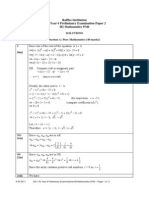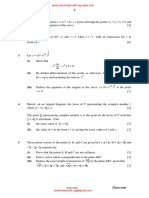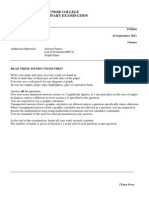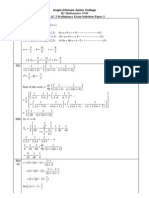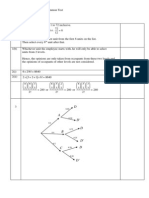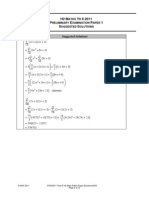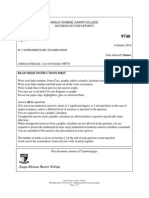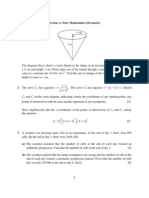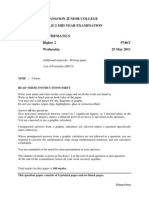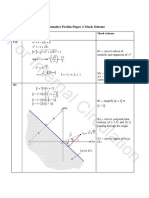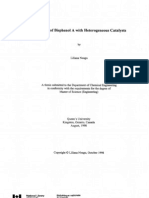RI H2 Maths 2013 Prelim P2 Solutions
RI H2 Maths 2013 Prelim P2 Solutions
Uploaded by
nej200695Copyright:
Available Formats
RI H2 Maths 2013 Prelim P2 Solutions
RI H2 Maths 2013 Prelim P2 Solutions
Uploaded by
nej200695Original Description:
Copyright
Available Formats
Share this document
Did you find this document useful?
Is this content inappropriate?
Copyright:
Available Formats
RI H2 Maths 2013 Prelim P2 Solutions
RI H2 Maths 2013 Prelim P2 Solutions
Uploaded by
nej200695Copyright:
Available Formats
RAFFLES INSTITUTION
2013 Year 6 Preliminary Examination Paper 2
H2 Mathematics 9740
No. Solution
1(i)
1
2
: 1 5
2
| |
|
[ =
|
|
\ .
r
and
7 2
: 2 1 , where
8 2
AC
l
| | | |
| |
= + e
| |
| |
\ . \ .
r
C is on
AC
l
7 2
2 for some
8 2
OC
+ | |
|
= + e
|
|
+
\ .
C is on
1
[
2
1 5
2
OC
| |
|
=
|
|
\ .
, i.e.
7 2 2
2 1 5
8 2 2
+ | | | |
| |
+ =
| |
| |
+
\ . \ .
(14 4 ) (2 ) (16 4 ) 5
3
+ + + + + =
=
Hence
7 2 1
2 3 1 = 1
8 2 2
OC
| | | | | |
| | |
=
| | |
| | |
\ . \ . \ .
, i.e. 2 OC = + i j k
(ii)
1 7 6
5 2 3
8 8 0
AB
| | | | | |
| | |
= =
| | |
| | |
\ . \ . \ .
//
2
1
0
| |
|
|
|
\ .
//
2
[ , since
2
[ contains
AB
l
2 1 2
[ [ [ // normal of
1
[ //
2
1
2
| |
|
|
|
\ .
Hence normal of
2
[ //
2 2 2
1 1 4
0 2 4
| | | | | |
| | |
=
| | |
| | |
\ . \ . \ .
//
1
2
2
| |
|
|
|
\ .
Equation of
2
[ is
1 7 1
2 2 2
2 8 2
| | | | | |
| | |
=
| | |
| | |
\ . \ . \ .
r , i.e. ( 2 2 ) 5 + = r i j k
(iii)
Since
2 2
2 1 4 2 2 0
1 2
| | | |
| |
= + + =
| |
| |
\ . \ .
and
2 1
2 2 2 4 2 0
1 2
| | | |
| |
= + =
| |
| |
\ . \ .
,
H2 MA 9740/P2/2013 RI Year 6 Preliminary Examination - Page 2 of 10
2 2 + + i j k is to both normal of
1
[ and normal of
2
[ .
Hence 2 2 + + i j k is parallel to l (verified).
From (i) and (ii), we can deduce that C is on both
1
[ and
2
[ .
Hence the cartesian equation of l is
1 ( 1) 2
2 2 1
x y z
= =
, i.e.
1 1
2
2 2
x y
z
+
= =
No. Solution
2(a)
(i)
From graph of
2
2 1
2 3
x
y
x x
+
=
+ +
shown above,
f
1
R 1 ,
2
k k
(
= + +
(
.
For gf to be a function,
f g
R D _ .
1 1
2 i.e.
2 2
k k k + < >
(ii)
f
11
R 4,
2
(
=
(
| |
gf
R 0, 1 =
(b) Since h( ) y x = passes through (1,1) and (2, 2) ,
3 2
(1) (1) (1) 1 a b c d + + + = (1)
3 2
(2) (2) (2) 2 a b c d + + + = (2)
Now
2
h ( ) 3 2 x ax bx c ' = + +
Since (2, 2) is a maximum point,
2
3 (2) 2 (2) 0 a b c + + =
12 4 0 a b c + + = (3)
Since ( 4,14) lies on graph of
( )
h y x = ,
either (4,14) or (4, 14) lies on graph of h( ) y x = ,
x
O
y
H2 MA 9740/P2/2013 RI Year 6 Preliminary Examination - Page 3 of 10
i.e. h(4) 14 or 14 = .
As h( ) x is strictly decreasing for 2 x > , h(4) h(2) 2 s = .
Hence h(4) 14 = and
3 2
(4) (4) (4) 14 a b c d + + + =
64 16 4 14 a b c d + + + = (4)
Solving (1) to (4) gives
1 a = , 4 b = , 4 c = , 2 d =
No. Solution
3(i)
2
d
2sin 4sin 8sin cos
d
y
y y u u u u
u
= = =
When
1
2, sin
4 2
y
t
u u = = =
When 4, sin 1
2
y
t
u u = = =
( )
( )
2
4
2
4
2
4
2
4
2
2
2
4 4 4sin
d 8sin cos d
4sin
cos
8sin cos d
sin
8 cos d
y
y
y
t
t
t
t
t
t
u
u u u
u
u
u u u
u
u u
=
=
=
} }
}
}
2
4
2
4
1 cos 2
8 d
2
sin 2
4
2
1
4
2 4 2
2
t
t
t
t
u
u
u
u
t t
t
+
=
(
= +
(
( | |
= +
| (
\ .
=
}
(ii) When 0, 2 x y = =
2
16 16 4
2 4 2 2
( 2) 4
y
y x
x y y
= = =
+
Since 2 x s ,
4
2 2
y
x
y
=
Required area
4
2
d x y =
}
H2 MA 9740/P2/2013 RI Year 6 Preliminary Examination - Page 4 of 10
| |
4
2
4
4
2
2
4
2 1 d
4
2 d
2[2 ( 2)]
2(4 )
y
y
y
y
y y
y
t
t
| |
=
|
|
\ .
=
`
)
=
=
}
}
(iii)
Required volume
2
2 2
0
(4 )(2) d y x t t =
}
2
2
2
0
16
32 d
( 2) 4
35.9 (3 s.f.)
x
x
t t
(
=
(
+
=
}
No. Solution
4(a) Since i z = is a root,
3
i 2i 0 i k k + + = =
Hence the equation becomes
3
2 i 0 z z + = .
3 2
2 i ( i)( 1) z z z z az + = + +
Comparing coefficient of
2
z , i a = .
For
2
i 1 0 z z + + = ,
2
i i 4(1)(1) i 5 i i 5
2(1) 2 2
z
= = =
Hence the other 2 roots are
i+i 5 i i 5
and
2 2
.
(b)
(i)
(ii)
1 1 1
[cos( ) i sin( )] (cos i sin )
w r r
u u u u = + =
500
3 40i
500
(cos i sin ) 3 40i
w
w
r
r
u u
= +
= +
Comparing real and imaginary parts,
H2 MA 9740/P2/2013 RI Year 6 Preliminary Examination - Page 5 of 10
(iii)
500 500
cos 3 , sin 40 r
r r
u u = =
2
3 40
cos , sin
500 500
r r
u u = =
2
2
2
4 2
2 2
2
3 40
1
500 500
9 1600 250000 0
( 100)(9 2500) 0
( 10)( 10)(9 2500) 0
r r
r r
r r
r r r
| |
| |
+ =
| |
\ .
\ .
+ =
+ =
+ + =
Since , 10 r r
+
e =
Subst 10 r = ,
3 4
cos , sin
5 5
u u = =
3 4
10 i 6 8i
5 5
w
| |
= =
|
\ .
Alternative Solution 1:
From
500
3 40i, w
w
= + consider the modulus of both sides to get
2 2
500
3 40i (3 ) 40 . r r
r
= + = + This leads directly to the same equation for r as above, and
is solved similarly to get 10. r = Then
500
6 8i.
3(10) 40i
w = =
+
Alternative Solution 2:
From
2
3 40
cos , sin ,
500 500
r r
u u = = eliminate r to get
( )
2
2 2
16
1 cos .
1
3 500 16
cos sin sin
500 4 15 5 0
u u u u
| |
= =
|
=
\ .
Solve this quadratic to get cos
3
,
5
u = rejecting the other root, and proceed to get
2
500
co 1 0. s 0
3
r u = = Thus 10 r = and
40 4
.
5
in
5
s
00
r u = = Finally
i sin co 6 i. s 8 w r u u + = =
H2 MA 9740/P2/2013 RI Year 6 Preliminary Examination - Page 6 of 10
Section B: Statistics [60 marks]
No. Solution
(i) Obtain the name list of all patients and number them from 1 to N , N being the number of
patients in the clinics records.
Then use a random number generator to obtain 200 numbers from 1 to N , and the patients
with the corresponding numbers will be selected as respondents.
(ii)
Use simple random
sampling to choose y
number of patients from
each age group as
shown in the table, with
the sample size y proportional to the number of patients within each age group.
Age
( x )
20 x s 20 35 x < s
35 50 x < s
50 x >
Sample
size
( y )
15
200
100
30
=
20
200
100
40
=
40
200
100
80
=
25
200
100
50
=
(iii) Simple random sampling may not give a fair representation of patients from different age
groups.
No. Solution
(i)
Number of arrangements
6
12! 6! 2 478955520 = =
(ii)
Number of arrangements
6 5
5
(5 1)! 2 5 4 92160 C = =
Or:
6 5 5
1 2
(5 1)! 2 C P ;
5
6 (6 1)! 2 4 ;
5 6
6 (7 1)! 2 (6 1)! 2 (
No. Solution
(i)
Let
n
R denote the event that a red ball is removed on the
th
n draw.
Let
m
W denote the event that a white ball is removed on the
th
m draw.
1 2
1
P( )
1
r r
R R
r w r w
=
+ +
(or using tree diagram)
2 1 2 1 2
P( ) P( ) P( )
1
1 1
R R R W R
r r w r
r w r w r w r w
r
r w
= +
= +
+ + + +
=
+
1 2
1 2
2
P( ) 1
P( | )
P( ) 1
R R r
R R
R r w
= =
+
H2 MA 9740/P2/2013 RI Year 6 Preliminary Examination - Page 7 of 10
(ii)
1 2 1 2
2
P( ) 1 P( )
1
1
1
2
( )( 1)
W W R R
r r
r w r w
wr w w
r w r w
=
=
+ +
+
=
+ +
(iii) If exactly one white ball remains in the box when the removal stops, ( 1) w white balls must
be removed in the first ( 2) r w + draws.
Required probability
2
( 2)!
1
( 1)!( 1)!
( )!
( )( 1)
! !
r w
r w
w wr w r
r w r w r w r w
w r
w
+ | |
+
|
\ .
= = =
+ + + + | |
|
\ .
No. Solution
(i) To test
0
H : 150 = vs
1
H : 150 < ,
where denotes the population mean lifetime of batteries.
Since p value = 0.0975 > 0.08, we do not reject
0
H and conclude that there is insufficient
evidence, at 8% level of significance, that the population mean lifetime of batteries is less
than 150 hours.
(ii)
10317
t
t
n n
= =
Under
0
H ,
2
0
~ N , T
n
| |
|
\ .
o
approximately by Central Limit Theorem, where
0
150, 16.877 o = = .
value P( ) 0.0975 p T t = s =
10317
150
P 0.0975
16.877
10317
150
1.29593
16.877
10317 21.871
150 0 (shown)
n
Z
n
n
n
n n
| |
|
s = |
|
|
\ .
=
+ =
Solve using GC, 70 n =
(iii) It is NOT necessary to assume that T is normally distributed, since the sample size n is large,
so by Central Limit Theorem, T is approximately normally distributed.
H2 MA 9740/P2/2013 RI Year 6 Preliminary Examination - Page 8 of 10
No. Solution
(i) From GC, 0.916 (3 s.f.) r =
(ii)
(iii) A linear model predicts the average height would increase continuously with no upper bound.
OR:
The scatter diagram does not show the points lie close to a straight line.
OR:
The scatter diagram shows that as x increases, y increases at a decreasing rate.
A quadratic model predicts that the average height reaches a maximum, then decreases with
time and eventually takes on negative values.
(iv) For the suggested model, the least square regression line is
6.11ln 6.10 y x = + .
The product moment correlation coefficient is 0.993 (3 s.f.).
When 5.5, 16.5 x y = =
Hence the average height is 16.5 feet.
Since 5.5 x = is within range of value of x , and the product moment correlation coefficient is
close to 1, suggesting a strong positive linear correlation between the 2 variables, the estimate
is reliable.
No. Solution
(i) ~ N(100 90, 25 36), i.e. ~ N(10, 61) X Y X Y +
( )
P 5 P( 5) P( 5)
0.73897 0.027394
0.766 (3 s.f.)
X Y X Y X Y > = > + <
= +
=
OR:
( ) ( )
P 5 1 P 5 X Y X Y > = <
1 P( 5 5)
1 0.23363
0.766 (3 s.f.)
X Y = < <
=
=
(ii)
2
1 2
1 2
3 ~ N(100 100 3(90), 25+25+3 (36))
i.e. 3 ~ N(470, 374)
X X Y
X X Y
+ + + +
+ +
1 2
P( 3 495) 0.0981 (3 s.f.) X X Y + + > =
Let T be the number of observations, out of 150, for which 90 Y < . Then ~ B(150, 0.5) T .
19.8
6
1
11
x
y
H2 MA 9740/P2/2013 RI Year 6 Preliminary Examination - Page 9 of 10
Since 150 n = is large such that 75 5 np = > and (1 ) 75 5 n p = > , ~ N(75, 37.5) T
approximately.
P( 68) P( 67.5) (by continuity correction)
0.88966 (5 d.p.)
T T > = >
=
No. Solution
(i)
Let M be the number of substandard medium eggs, out of 10.
Then ~ B 10,
100
m
M
| |
|
\ .
.
2 8
10
2
P( 2) 0.3 1 0.3
100 100
m m
M C
| | | |
= = =
| |
\ . \ .
From graphic calculator,
18.6 (3 s.f.) m = or 21.5 (3 s.f.) (rejected since 20 m < )
(ii)
Let X be the number of small eggs, out of 30.
Let Y be the number of large eggs, out of 10.
Then ~ B(30, 0.18) X and ~ B(10, 0.08) Y .
Required probability
P( 5) P(6 7)P( 1)
P( 5) [P( 7) P( 5)][1 P( 0)]
0.53946 (0.84179 0.53946)(1 0.43439)
0.710 (3 s.f.)
X X Y
X X X Y
= s + s s >
= s + s s =
~ +
=
(iii)
Let W be the number of large eggs, out of 60.
Then ~ B(60, 0.08) W .
Since 60 50 n = > is large, 0.08 0.1 p = < is small such that
4.8 5 np = < , ~ Po(4.8) W approximately.
Required probability P( 4) W = s
= 0.476 (3 s.f.)
(iv)
Assume that the daily demand of eggs in the morning and that in the afternoon are
independent.
(v)
Let T be the total daily demand of eggs, in trays of 30.
Then ~ Po(5 19 5 9), i.e. ~ Po(140) T T + .
Let k be the number of trays of eggs the supermarket stocks up each day. We need
H2 MA 9740/P2/2013 RI Year 6 Preliminary Examination - Page 10 of 10
P( ) 0.9 T k s > .
From graphic calculator,
when 154 k = , P( ) 0.88859 0.9 T k s = <
when 155 k = , P( ) 0.90332 0.9 T k s = >
when 156 k = , P( ) 0.91655 0.9 T k s = >
Hence, least value of 155 k = .
You might also like
- Yjc h2 Math p1 SolutionsDocument12 pagesYjc h2 Math p1 SolutionsjimmytanlimlongNo ratings yet
- Dhs h2 Math p2 SolutionDocument14 pagesDhs h2 Math p2 SolutionjimmytanlimlongNo ratings yet
- 2007 Ajc h2 Prelims Paper 1 SolutionsDocument9 pages2007 Ajc h2 Prelims Paper 1 Solutionsvincesee85No ratings yet
- Ri h2 Math p2 SolutionsDocument11 pagesRi h2 Math p2 SolutionsjimmytanlimlongNo ratings yet
- RVHS JC 2 H2 Maths 2011 Mid Year Exam SolutionsDocument14 pagesRVHS JC 2 H2 Maths 2011 Mid Year Exam SolutionsjimmytanlimlongNo ratings yet
- TJC h2 Math p1 SolutionDocument12 pagesTJC h2 Math p1 SolutionjimmytanlimlongNo ratings yet
- AJC H2 Math 2013 Prelim P2Document6 pagesAJC H2 Math 2013 Prelim P2nej200695No ratings yet
- 2015 HCI Prelim Paper 2 SolutionsDocument13 pages2015 HCI Prelim Paper 2 SolutionsnasyrahNo ratings yet
- EJC H2 Math P1 With Solution PDFDocument23 pagesEJC H2 Math P1 With Solution PDFKipp SohNo ratings yet
- 2014 H2 Maths Prelim Papers - HCI P2 Solution PDFDocument14 pages2014 H2 Maths Prelim Papers - HCI P2 Solution PDFcherylhzy100% (1)
- 2010 TJC SolDocument12 pages2010 TJC SolPooja KapurNo ratings yet
- IJC H2Maths 2013 Promo SolnDocument25 pagesIJC H2Maths 2013 Promo Solnwnwd97No ratings yet
- MJC 2015 H2 J1 Math Promos QuestionsDocument7 pagesMJC 2015 H2 J1 Math Promos QuestionsAlxNo ratings yet
- 2007 RJC Math PrelimDocument32 pages2007 RJC Math PrelimDaniel Oon Wei RhenNo ratings yet
- 2007 IJC PrelimDocument23 pages2007 IJC PrelimWen LongNo ratings yet
- Sajc 2010 Prelim Math p1 SolnDocument10 pagesSajc 2010 Prelim Math p1 SolnAh XiuNo ratings yet
- Nyjc H2 Math P2Document6 pagesNyjc H2 Math P2jimmytanlimlongNo ratings yet
- 2014 H2 Maths Prelim Papers - RJC P1 Solution PDFDocument12 pages2014 H2 Maths Prelim Papers - RJC P1 Solution PDFcherylhzyNo ratings yet
- NYJC 2009 Prelim H2 P2 QuestionDocument14 pagesNYJC 2009 Prelim H2 P2 QuestioncjcsucksNo ratings yet
- AJC H2 Math 2013 Prelim P2Document6 pagesAJC H2 Math 2013 Prelim P2nej200695No ratings yet
- AJC H2 Math 2013 Prelim P2Document6 pagesAJC H2 Math 2013 Prelim P2nej200695No ratings yet
- Kamphuis Introduction To Coastal Engineering and MangaementDocument470 pagesKamphuis Introduction To Coastal Engineering and Mangaementagapitosimeon100% (4)
- Acjc h2 Math p2 SolutionsDocument8 pagesAcjc h2 Math p2 SolutionsjimmytanlimlongNo ratings yet
- NJC JC 2 H2 Maths 2011 Mid Year Exam SolutionsDocument10 pagesNJC JC 2 H2 Maths 2011 Mid Year Exam SolutionsjimmytanlimlongNo ratings yet
- Dhs h2 Math p1 SolutionDocument11 pagesDhs h2 Math p1 SolutionjimmytanlimlongNo ratings yet
- 2013 - 2014 H2 Maths JJC Promo SolnsDocument11 pages2013 - 2014 H2 Maths JJC Promo SolnsLionel Torres LeeNo ratings yet
- MJC JC 2 H2 Maths 2011 Mid Year Exam Solutions Paper 2Document11 pagesMJC JC 2 H2 Maths 2011 Mid Year Exam Solutions Paper 2jimmytanlimlongNo ratings yet
- NYJC JC 2 H2 Maths 2011 Mid Year Exam Solutions Paper 2Document7 pagesNYJC JC 2 H2 Maths 2011 Mid Year Exam Solutions Paper 2jimmytanlimlongNo ratings yet
- 2006 AJC H2 MY SolnDocument9 pages2006 AJC H2 MY Solnjunie9201No ratings yet
- JJC JC 2 H2 Maths 2011 Mid Year Exam SolutionsDocument14 pagesJJC JC 2 H2 Maths 2011 Mid Year Exam SolutionsjimmytanlimlongNo ratings yet
- HCI H2 Maths 2012 Prelim P1 SolutionsDocument12 pagesHCI H2 Maths 2012 Prelim P1 Solutionsnej200695No ratings yet
- HCI 2008 Prelim Paper 2 Solution QN Solution 1Document5 pagesHCI 2008 Prelim Paper 2 Solution QN Solution 1Yao Le Titanium ChenNo ratings yet
- 2006 JC 1 H2 JCT & Promo - Differential EquationsDocument3 pages2006 JC 1 H2 JCT & Promo - Differential EquationsOccamsRazorNo ratings yet
- MJC JC 2 H2 Maths 2011 Mid Year Exam Questions Paper 1Document8 pagesMJC JC 2 H2 Maths 2011 Mid Year Exam Questions Paper 1jimmytanlimlongNo ratings yet
- Https:Tohjid - Sgp1.digitaloceanspaces - com:Sgfreepapers:Exam-papers:2018:Junior-college:Jc1:2018 Jc1 Math PromoDocument333 pagesHttps:Tohjid - Sgp1.digitaloceanspaces - com:Sgfreepapers:Exam-papers:2018:Junior-college:Jc1:2018 Jc1 Math PromoliusihanNo ratings yet
- MJC JC 2 H2 Maths 2011 Mid Year Exam Questions Paper 2Document10 pagesMJC JC 2 H2 Maths 2011 Mid Year Exam Questions Paper 2jimmytanlimlongNo ratings yet
- ACJC 2014 H2 Math JC2 Supp QP PaperDocument7 pagesACJC 2014 H2 Math JC2 Supp QP PaperRaymondZhang100% (1)
- VJC JC 2 H2 Maths 2011 Mid Year Exam QuestionsDocument4 pagesVJC JC 2 H2 Maths 2011 Mid Year Exam QuestionsjimmytanlimlongNo ratings yet
- Promo08 Hci H2 (Qn+soln)Document12 pagesPromo08 Hci H2 (Qn+soln)toh tim lamNo ratings yet
- ACJC Maths Promos 2005Document3 pagesACJC Maths Promos 2005Suphadetch LeungNo ratings yet
- SRJC JC 2 H2 Maths 2011 Mid Year Exam Questions Solutions Paper 1Document18 pagesSRJC JC 2 H2 Maths 2011 Mid Year Exam Questions Solutions Paper 1jimmytanlimlongNo ratings yet
- NYJC JC 2 H2 Maths 2011 Mid Year Exam Question Paper 1Document5 pagesNYJC JC 2 H2 Maths 2011 Mid Year Exam Question Paper 1jimmytanlimlongNo ratings yet
- SRJC JC 2 H2 Maths 2011 Mid Year Exam Questions Solutions Paper 2Document15 pagesSRJC JC 2 H2 Maths 2011 Mid Year Exam Questions Solutions Paper 2jimmytanlimlongNo ratings yet
- 2014 - DHS - Prelim Paper 2Document7 pages2014 - DHS - Prelim Paper 2Ng Shu QingNo ratings yet
- AJC H2Maths 2012prelim P1 SolutionDocument6 pagesAJC H2Maths 2012prelim P1 SolutionMelinda BowmanNo ratings yet
- 2006 AJC H2 Maths Promo - QuestionsDocument6 pages2006 AJC H2 Maths Promo - QuestionsniveumaNo ratings yet
- 1 (A) Suppose The Following Facts Are Known About The Function G and Its DerivativeDocument5 pages1 (A) Suppose The Following Facts Are Known About The Function G and Its DerivativeShereen LimNo ratings yet
- 2010 AJC Paper 2Document5 pages2010 AJC Paper 2Fang Wen LimNo ratings yet
- 2013 HCI Prelim Paper 2 Mark SchemeDocument13 pages2013 HCI Prelim Paper 2 Mark SchemeYan Shen TanNo ratings yet
- Acjc h2 Maths p1 QN PaperDocument6 pagesAcjc h2 Maths p1 QN Papervincesee85No ratings yet
- 2014 H2 Maths Prelim Papers - JJC P1 Solution PDFDocument12 pages2014 H2 Maths Prelim Papers - JJC P1 Solution PDFcherylhzyNo ratings yet
- 2008 A Levels P1 (No Worked Soln) and P2Document6 pages2008 A Levels P1 (No Worked Soln) and P2toh tim lamNo ratings yet
- RI JC 2 H2 Maths 2011 Mid Year Exam QuestionsDocument6 pagesRI JC 2 H2 Maths 2011 Mid Year Exam QuestionsjimmytanlimlongNo ratings yet
- 4047 Specimen Paper 2 SolutionsDocument16 pages4047 Specimen Paper 2 SolutionsLester LimNo ratings yet
- 2020 JC2 H2 Math Lecture Test 1 (Solution)Document5 pages2020 JC2 H2 Math Lecture Test 1 (Solution)Timothy HandokoNo ratings yet
- Hci H2 Math P2Document6 pagesHci H2 Math P2jimmytanlimlongNo ratings yet
- 4E 2009 ZhongHua Prelim 2 Maths Paper 1Document18 pages4E 2009 ZhongHua Prelim 2 Maths Paper 1ZeneonNo ratings yet
- ACJC 2011 PrelimDocument14 pagesACJC 2011 PrelimUmehara EriNo ratings yet
- AJC H2 Math 2013 Prelim P1 SolutionsDocument15 pagesAJC H2 Math 2013 Prelim P1 Solutionsnej200695No ratings yet
- Yjc h2 Math p2 SolutionsDocument8 pagesYjc h2 Math p2 SolutionsjimmytanlimlongNo ratings yet
- RI H2 Maths 2013 Prelim P1 SolutionsDocument13 pagesRI H2 Maths 2013 Prelim P1 Solutionsnej200695100% (1)
- 2009 SRJC Paper2 SolutionsDocument24 pages2009 SRJC Paper2 SolutionsFang Wen LimNo ratings yet
- 2007 YJC Paper 1solDocument12 pages2007 YJC Paper 1solYudi KhoNo ratings yet
- Broader Perspectives 2013 03 Compre Answers PDFDocument10 pagesBroader Perspectives 2013 03 Compre Answers PDFnej200695100% (1)
- TED Talk TranscriptsDocument12 pagesTED Talk Transcriptsnej200695No ratings yet
- HCI H2 Maths 2012 Prelim P1 SolutionsDocument12 pagesHCI H2 Maths 2012 Prelim P1 Solutionsnej200695No ratings yet
- RI H2 Maths 2013 Prelim P1 SolutionsDocument13 pagesRI H2 Maths 2013 Prelim P1 Solutionsnej200695100% (1)
- RI H2 Maths 2013 Prelim P1Document4 pagesRI H2 Maths 2013 Prelim P1nej200695No ratings yet
- AJC H2 Math 2013 Prelim P1Document6 pagesAJC H2 Math 2013 Prelim P1nej200695No ratings yet
- AJC H2 Math 2013 Prelim P1 SolutionsDocument15 pagesAJC H2 Math 2013 Prelim P1 Solutionsnej200695No ratings yet
- Graphing Techniques WorksheetDocument2 pagesGraphing Techniques Worksheetnej200695No ratings yet
- Complex Numbers WorksheetDocument1 pageComplex Numbers Worksheetnej200695No ratings yet
- Tutor Registration FormDocument10 pagesTutor Registration Formkumaresanmanika2543No ratings yet
- Bisphenol ADocument198 pagesBisphenol AVijaykumar Marakatti100% (3)
- EURL-FA Guide: Protocol For Verification Studies of Single-Laboratory/in-House Validated MethodsDocument26 pagesEURL-FA Guide: Protocol For Verification Studies of Single-Laboratory/in-House Validated MethodsEmilianNo ratings yet
- Formula Booklet Physics XIDocument35 pagesFormula Booklet Physics XILokesh Kumar80% (5)
- S & S 2 MarksDocument30 pagesS & S 2 MarkspriyajegaNo ratings yet
- ChainDocument2 pagesChainmyusuf_engineerNo ratings yet
- Active and Semi-Active Vibration Isolation: D. KarnoppDocument9 pagesActive and Semi-Active Vibration Isolation: D. KarnoppDiabloNo ratings yet
- High-Field Laser Physics: ETH Zürich Spring Semester 2010 H. R. ReissDocument18 pagesHigh-Field Laser Physics: ETH Zürich Spring Semester 2010 H. R. ReissjasmonNo ratings yet
- Exercise PDFDocument37 pagesExercise PDFIntel comNo ratings yet
- PDM 82 Aligned My36nDocument10 pagesPDM 82 Aligned My36nArbaz100% (1)
- Chapter 1 Properties of Reinforced ConcreteDocument51 pagesChapter 1 Properties of Reinforced ConcreteSochan Seng90% (10)
- Linear Algebra For Test and Analysis: Imac - XixDocument74 pagesLinear Algebra For Test and Analysis: Imac - XixVitor PereiraNo ratings yet
- Introduction To Fluid MechanicsDocument28 pagesIntroduction To Fluid MechanicsMavu IndenciaNo ratings yet
- Cyclotron 2Document9 pagesCyclotron 2M ABDULLAHNo ratings yet
- AVP - DryingDocument42 pagesAVP - DryingVinayak Thalange100% (1)
- Technical Information Kolliphor ELpDocument4 pagesTechnical Information Kolliphor ELpAndrésJiménezNo ratings yet
- Triton x-305 PDFDocument2 pagesTriton x-305 PDFAnonymous C3BD7OdNo ratings yet
- Chemistry 31 - Quantitative Analysis Exam #2, April 22, 2009Document6 pagesChemistry 31 - Quantitative Analysis Exam #2, April 22, 2009Agatha BermudezNo ratings yet
- Tutorial 3 ThermoDocument27 pagesTutorial 3 ThermoHaiqal AzizNo ratings yet
- Dimensional AnalysisDocument3 pagesDimensional AnalysisDeepakrao Bornare PatilNo ratings yet
- Carbon-Steam Reaction at Elevated TemperatureDocument4 pagesCarbon-Steam Reaction at Elevated Temperatureioan_vNo ratings yet
- TransientDocument888 pagesTransientBimantara PrayogoNo ratings yet
- 2007 - Shellac in PolymerDocument43 pages2007 - Shellac in PolymerAnonymous x7VY8VF7No ratings yet
- Specialty Optical Fiber Sensing Cable (Sofsc) : Linking The Oil and Gas Industry From End To EndDocument4 pagesSpecialty Optical Fiber Sensing Cable (Sofsc) : Linking The Oil and Gas Industry From End To Endddaalayamoct313024No ratings yet
- ACD Lab Manual Spur Gear DesignDocument4 pagesACD Lab Manual Spur Gear Designbalaguru780% (1)
- Handbook For PVC PipesDocument158 pagesHandbook For PVC PipesomoyegunNo ratings yet
- DTFT, DFT, FFT PDFDocument14 pagesDTFT, DFT, FFT PDFsamiNo ratings yet
- The Particle Nature of MatterDocument70 pagesThe Particle Nature of MatterWowie FalcatanNo ratings yet
- Pultruded Fiber-Reinforced Composite Distribution Poles Review of Cantilever Test Result Rev. 1Document25 pagesPultruded Fiber-Reinforced Composite Distribution Poles Review of Cantilever Test Result Rev. 1Sandeep JoshiNo ratings yet



